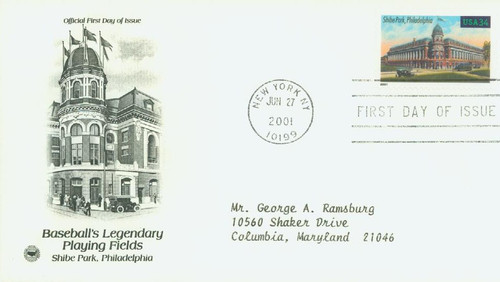
# 3518 - 2001 34c Legendary Baseball Fields: Shibe Park
34¢ Shibe Park
Baseball’s Legendary Playing Fields
City: New York, NY, Boston, MA, Chicago, IL, or Detroit, MI
Quantity: 125,000,000
Printed by: Avery Dennison
Printing Method: Photogravure
Perforations: Serpentine Die Cut 11.25 x 11.5
Color: Multicolor
Birth of “Lefty” Grove
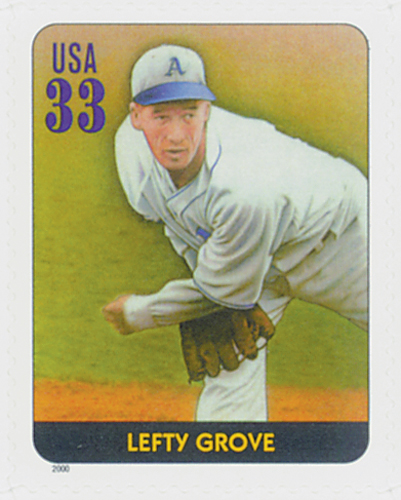
Robert Moses “Lefty” Grove was born on March 6, 1900, in Lonaconing, Maryland. Considered one of the greatest pitchers in history, he was a six-time All-Star, American League MVP, nine-time ERA leader, four-time wins leader, and two-time Triple Crown winner.
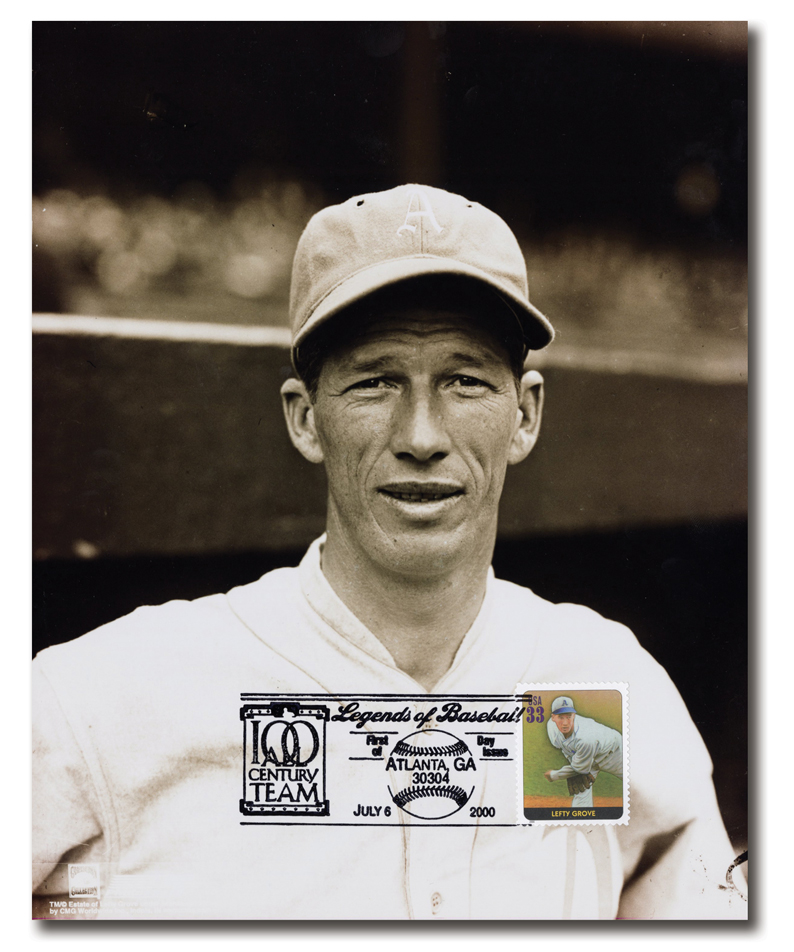
As a child, Grove reportedly strengthened his throwing arm by pitching rocks. In his teens he was a sandlot star around Baltimore, and didn’t play organized baseball until he was 19. Gove made his professional debut in 1920 with the Martinsburg Mountaineers in the class-D Blue Ridge League. He played in six games, pitching 59 innings, allowing just 30 hits, with an earned run average (ERA) of 1.68.

Grove’s impressive performance with the Mountaineers grabbed the attention of Jack Dunn, owner and manager of the Baltimore Orioles minor league team. Dunn offered the team money to replace their center field wall in exchange for Grove. Grove joined the team partway through the 1920 season and had a 12-2 record. Over the course of the next four seasons, he had 96 wins and 34 losses and led the league in strikeouts every year.

In 1925, the Philadelphia Athletics paid $100,600 for Grove – a record amount for a single player up to that time. Grove’s first season was plagued with injuries and it would be his only losing record (10-12) during his 17-year major league career. Despite a high ERA, he still led the league in strikeouts. Grove’s record improved the following season, in which he won the first of a record nine ERA titles. He had his first 20-win season in 1927 and tied for the most wins in 1928 with 24.
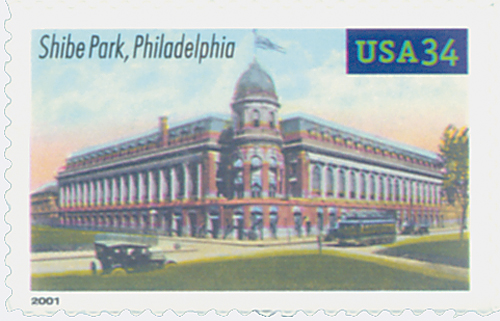
Between 1929 and 1931, the Athletics won the American League pennant every year and the World Series between 1929 and 1930. Grove was the league’s top pitcher, leading in wins, ERA, strikeouts, win percentage, complete games, and shutouts. In 1931, he became one of just a few pitchers to be selected as the league Most Valuable Player (MVP).
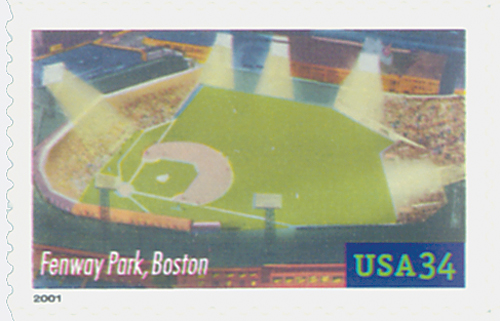
The team failed to win the pennant in 1932 and 1933. And in 1933, Grove became the first player in MLB history to strike out five times in a nine-inning game. At the end of that season, he was traded to the Boston Red Sox. Once again, an injury led to a poor record during his first season with the Red Sox. But in 1935 he bounced back with a 20-12 record and the league’s best ERA. Grove had several strong season with the Red Sox – he won his seventh and eight ERA titles and pitched over 200 innings for the 11th time in his career in 1937. He also led the league in ERAs four times between 1935 and 1939. During his final season, Grove won and lost seven games and made his final appearance on September 28, 1941.
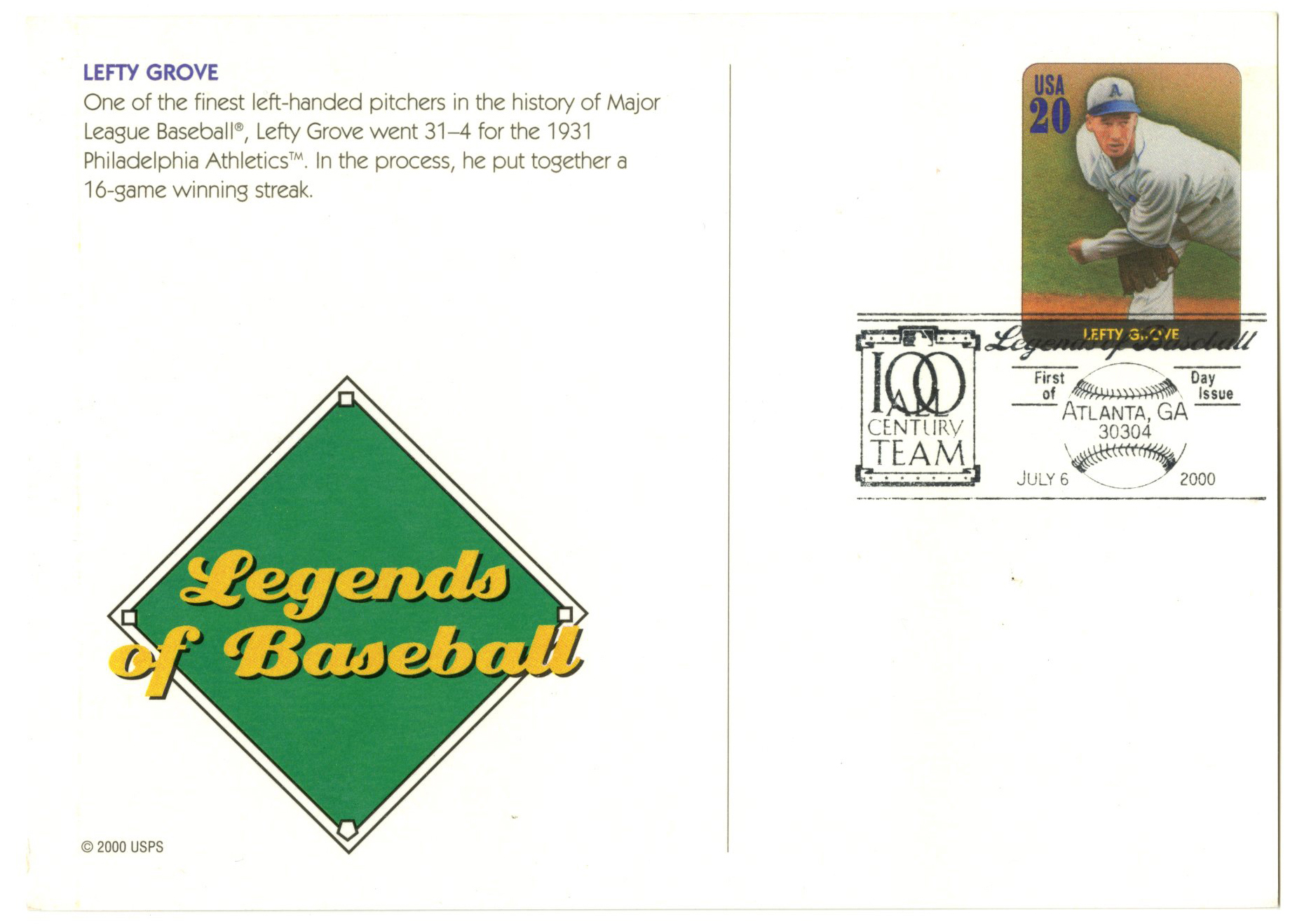
Grove ended his 17-year baseball career with 300 wins and 141 loses. When his minor league statistics are added, his record jumps to 411 wins and 190 losses, one of the best records in the history of organized baseball. Grove was the last to pitch 300 wins until 1963. His career highlights include eight 20-win seasons; seven consecutive seasons as American League strikeout leader; and a record nine seasons with the league’s lowest ERA. He also won the pitcher’s Triple Crown twice, leading the league in wins, strikeouts, and ERA.
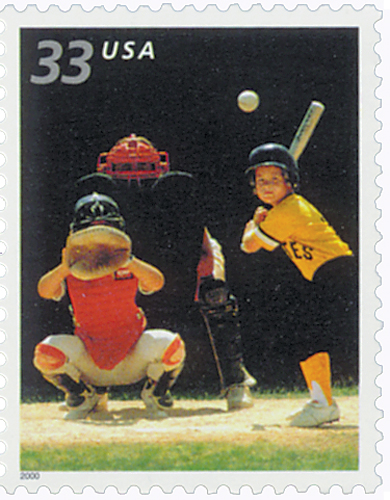
After retiring, Grove served on the Lonaconing town council and as the police chief. He also ran a bowling alley and donated jerseys and equipment to local youth baseball teams. He was elected to the Baseball Hall of Fame in 1947 and is often ranked among the best pitchers in major league history. Grove died on May 22, 1975. In 2019, a memorial was unveiled in his hometown of Lonaconing, Maryland.
34¢ Shibe Park
Baseball’s Legendary Playing Fields
City: New York, NY, Boston, MA, Chicago, IL, or Detroit, MI
Quantity: 125,000,000
Printed by: Avery Dennison
Printing Method: Photogravure
Perforations: Serpentine Die Cut 11.25 x 11.5
Color: Multicolor
Birth of “Lefty” Grove

Robert Moses “Lefty” Grove was born on March 6, 1900, in Lonaconing, Maryland. Considered one of the greatest pitchers in history, he was a six-time All-Star, American League MVP, nine-time ERA leader, four-time wins leader, and two-time Triple Crown winner.

As a child, Grove reportedly strengthened his throwing arm by pitching rocks. In his teens he was a sandlot star around Baltimore, and didn’t play organized baseball until he was 19. Gove made his professional debut in 1920 with the Martinsburg Mountaineers in the class-D Blue Ridge League. He played in six games, pitching 59 innings, allowing just 30 hits, with an earned run average (ERA) of 1.68.

Grove’s impressive performance with the Mountaineers grabbed the attention of Jack Dunn, owner and manager of the Baltimore Orioles minor league team. Dunn offered the team money to replace their center field wall in exchange for Grove. Grove joined the team partway through the 1920 season and had a 12-2 record. Over the course of the next four seasons, he had 96 wins and 34 losses and led the league in strikeouts every year.

In 1925, the Philadelphia Athletics paid $100,600 for Grove – a record amount for a single player up to that time. Grove’s first season was plagued with injuries and it would be his only losing record (10-12) during his 17-year major league career. Despite a high ERA, he still led the league in strikeouts. Grove’s record improved the following season, in which he won the first of a record nine ERA titles. He had his first 20-win season in 1927 and tied for the most wins in 1928 with 24.

Between 1929 and 1931, the Athletics won the American League pennant every year and the World Series between 1929 and 1930. Grove was the league’s top pitcher, leading in wins, ERA, strikeouts, win percentage, complete games, and shutouts. In 1931, he became one of just a few pitchers to be selected as the league Most Valuable Player (MVP).

The team failed to win the pennant in 1932 and 1933. And in 1933, Grove became the first player in MLB history to strike out five times in a nine-inning game. At the end of that season, he was traded to the Boston Red Sox. Once again, an injury led to a poor record during his first season with the Red Sox. But in 1935 he bounced back with a 20-12 record and the league’s best ERA. Grove had several strong season with the Red Sox – he won his seventh and eight ERA titles and pitched over 200 innings for the 11th time in his career in 1937. He also led the league in ERAs four times between 1935 and 1939. During his final season, Grove won and lost seven games and made his final appearance on September 28, 1941.

Grove ended his 17-year baseball career with 300 wins and 141 loses. When his minor league statistics are added, his record jumps to 411 wins and 190 losses, one of the best records in the history of organized baseball. Grove was the last to pitch 300 wins until 1963. His career highlights include eight 20-win seasons; seven consecutive seasons as American League strikeout leader; and a record nine seasons with the league’s lowest ERA. He also won the pitcher’s Triple Crown twice, leading the league in wins, strikeouts, and ERA.

After retiring, Grove served on the Lonaconing town council and as the police chief. He also ran a bowling alley and donated jerseys and equipment to local youth baseball teams. He was elected to the Baseball Hall of Fame in 1947 and is often ranked among the best pitchers in major league history. Grove died on May 22, 1975. In 2019, a memorial was unveiled in his hometown of Lonaconing, Maryland.










